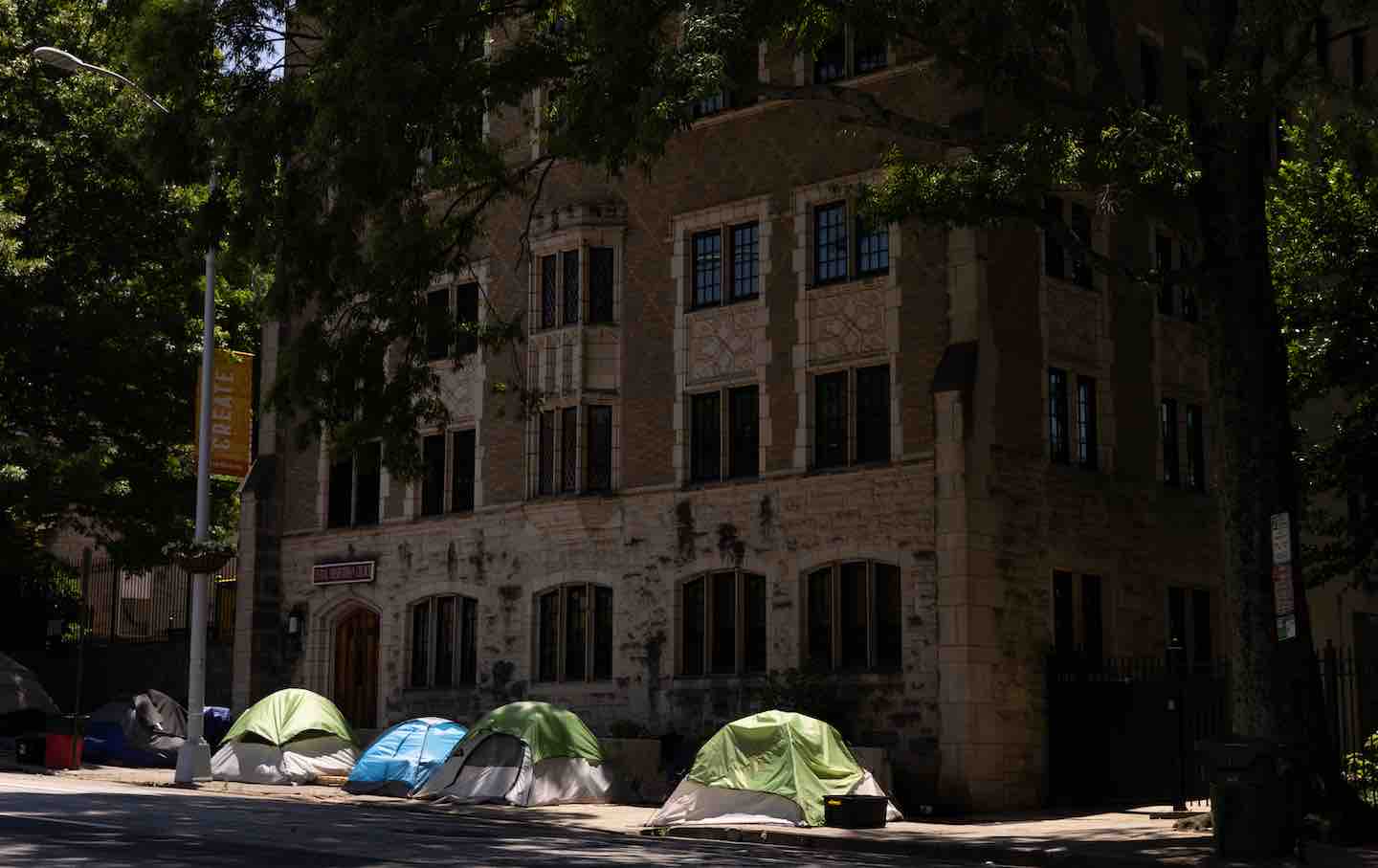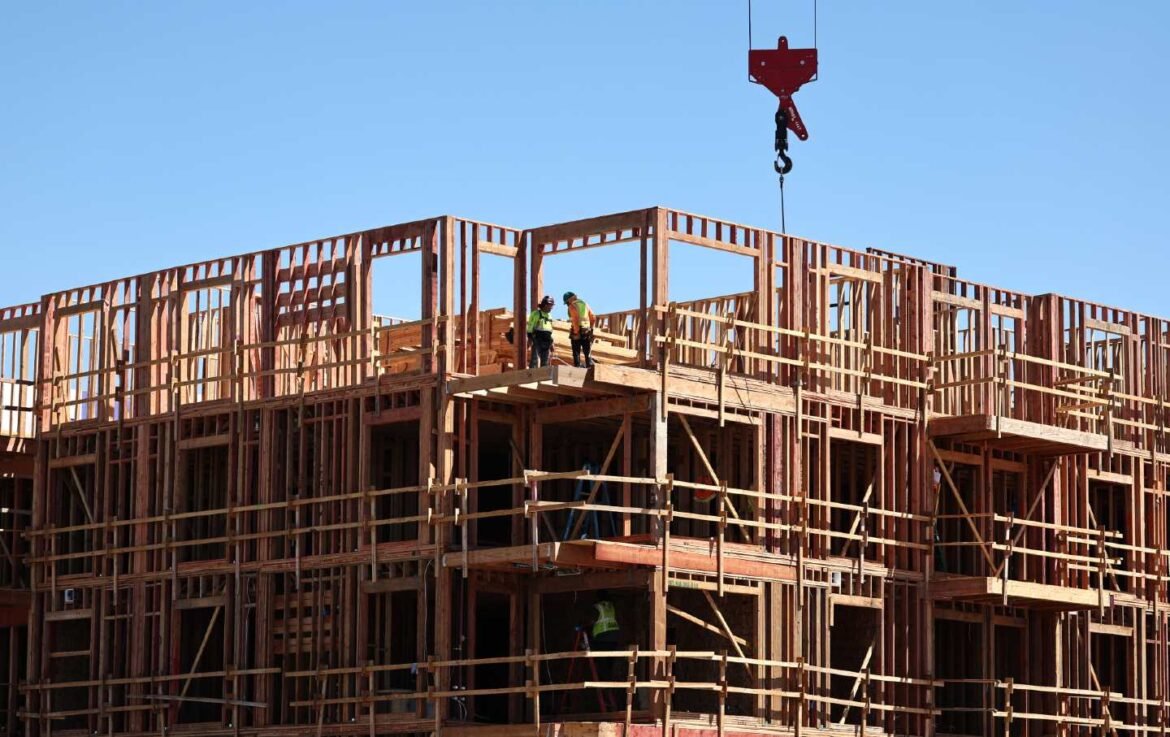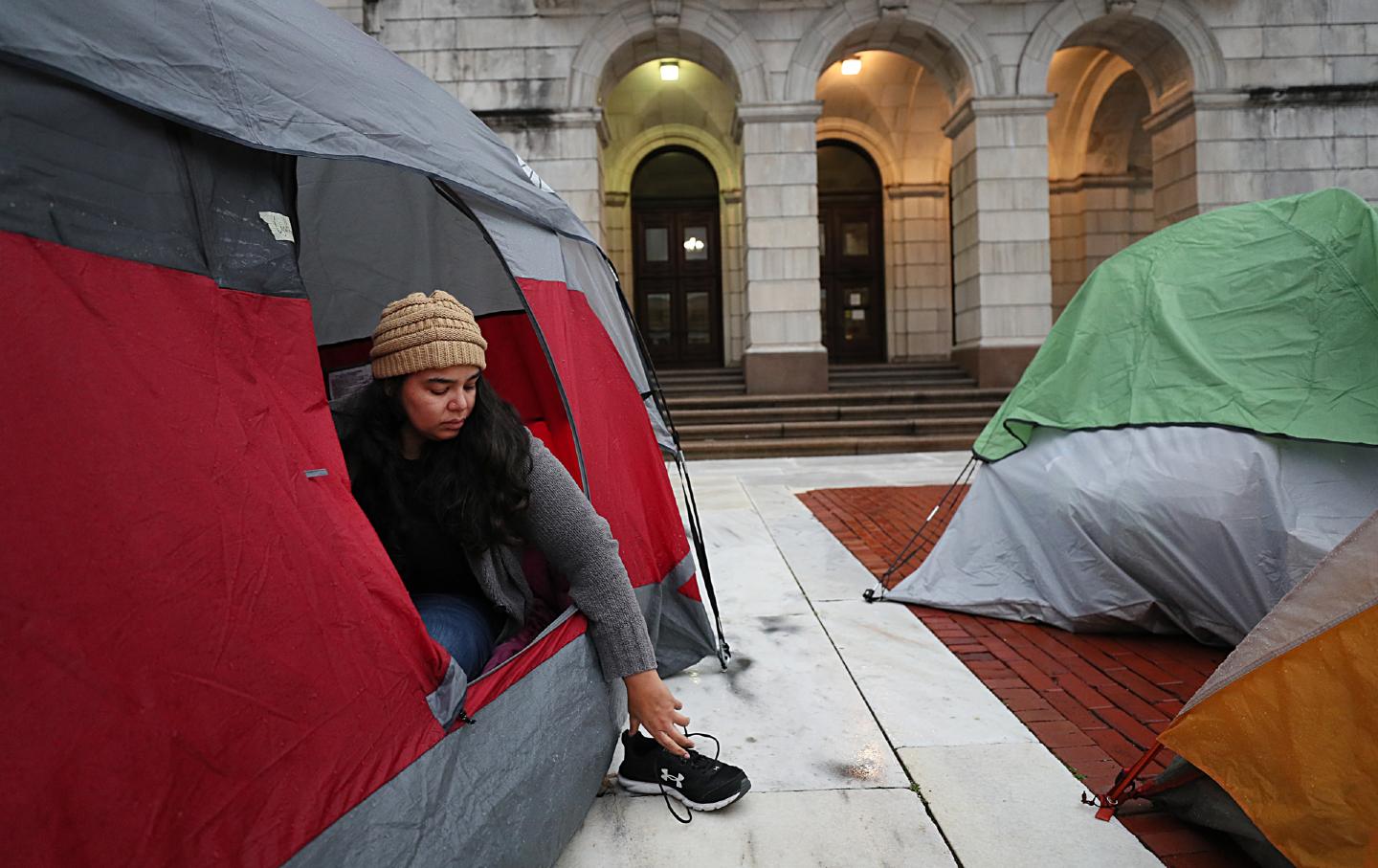April 28, 2025
Pro-housing advocates offer an analysis of class relations that is more sophisticated and has more explanatory power than the one held by many critics of the “abundance agenda.”

Construction continues on a mixed-use apartment complex that will hold more than 700 units of housing and 95,000 square feet of commercial space on August 20, 2024, in Los Angeles.
(Mario Tama / Getty Images)
“Abundance” is a slippery term. In their recent book, appropriately titled Abundance, Ezra Klein and Derek Thompson describe it as a “a simple idea: [that] to have the future we want, we need to build and invent more of what we need,” including housing, green energy, public transportation, and so on. But to critics on the left, abundance is, at best, a list of policy ideas without a theory of power—a dry, technocratic exercise with no political core.
To Paul Glastris and Nate Weisberg, for instance, abundance liberalism is a reboot of the Democratic Leadership Council, “a group of centrist thinkers plotting a revival of liberalism by way of pragmatism and policy innovation.” In The Nation, Jeet Heer recently wrote that abundance “amounts to a new iteration of neoliberalism promoting deregulation and business-friendly policies.” And in Rolling Stone, David Sirota and Aaron Regunberg argue that abundance liberalism “writes America’s central scarcity problem—corporate power—out of the economic story.”
If these critiques sound vaguely familiar, it’s because nearly identical charges have been made against the “yes in my backyard” (YIMBY) movement for years. And “abundance” is something like the YIMBY conceptual framework generalized to a number of other policy areas. (Glastris and Weisberg, bizarrely, credit abundance wonks for inspiring the YIMBY movement, though it was very much the other way around; the phrase “abundance agenda” was coined only in 2022, whereas YIMBYism dates back to Obama’s second term.)
Opponents on the left have long accused YIMBYs of refusing to engage with questions of power. YIMBYism has been, according to one critic, “a promise that we didn’t need to redistribute anything [because we] could just make more property.” In In Defense of Housing, an early entry in the left-anti-YIMBY genre, David Madden and Peter Marcuse argue that “free market boosters” fail to understand that the “balance of power between tenants and landlords, or between real estate owners and communities, cannot be determined in a neutral, apolitical way.” Of upzoning and permitting reform, they write that “removing the regulations that rein in property owners shifts power towards capital and away from residents.”
It is difficult to evaluate the strength of these arguments when applied to abundance liberalism writ large, because “abundance” means so many things to so many people. Even YIMBYism is hardly a single thing: There are centrist Democratic YIMBYs, but also DSA YIMBYs, libertarian YIMBYs, center-right YIMBYs, and so on. (There are even spineless, reformist social-democrat YIMBYs like me.)
But plenty of YIMBYs do, in fact, think deeply about issues of power. Many left YIMBYs in particular have an understanding of class and power relations that is superior—both in its sophistication and in its explanatory force—to the one offered by many of their critics. Their pro-housing advocacy is not an attempt to avoid questions of power but to confront them head-on.
To understand the left-YIMBY analysis, it is helpful to look at where its critics fall short. Above, Madden and Marcuse (who died in 2022) sketch out a bipolar class system, in which “real estate owners” are pitted against “communities.” This is a common device in anti-YIMBY writing, but it is wildly out of step with the reality that most American families—nearly two-thirds, to be a little more precise—are homeowners. Even in those relatively dense cities where the homeownership rate falls below 50 percent, plenty of homes are still owner-occupied. In Manhattan, the homeownership rate is 25 percent and climbing. One-third of Brooklynites own their home. The homeownership rates in San Francisco, Cook County (home of Chicago), and Los Angeles County are, respectively, 44 percent, 63 percent, and 49 percent.
Madden, Marcuse, and many of their anti-YIMBY compatriots are operating in a self-consciously Marxian frame of reference. But ironically, their biggest intellectual failing when it comes to the politics of housing is their inability to think dialectically. “Capital” and “the community” emerge from their analysis as homogeneous, inert blobs. They would have come closer to the mark if they had instead followed the Marxist historian E.P. Thompson’s dictum not to “see class as a ‘structure,’ nor even as a ‘category,’ but as something which in fact happens (and can be shown to have happened) in human relationships.” Thompson’s example teaches us to derive our class analysis from real-world, observable dynamics instead of trying to compress the evidence to fit a set of prefabricated ideas.
Much of the class conflict in housing politics takes place not between Big Real Estate and local communities but within communities: Affluent homeowners, particularly when they are organized into neighborhood associations, form powerful anti-housing blocs. Political science research has found that the people most likely to speak out against housing development during public hearings tend to be older, whiter, wealthier homeowners. Their opposition to new construction helps ensure the persistence of regional housing shortages, which drives up rents and locks first-time homebuyers out of the housing market.
Some of this opposition stems from an understandable resistance to change: Many homeowners like their neighborhoods the way they are and want to keep them that way. But many affluent homeowners have other more concrete reasons for wanting to keep new homes out of their backyards.
NIMBYs will often cite property values as a reason for opposing multifamily development: The presence of apartment buildings, they argue, blights single-family neighborhoods and makes their homes less valuable. The actual effects of upzoning and multifamily construction on home values are a bit more nuanced—in some cases, building affordable housing has been found to enhance the value of nearby single-family homes—but no matter. As the economist William Fischel argued in The Homevoter Hypothesis, any sort of change to a neighborhood’s built environment introduces a certain amount of financial risk for homeowners: “NIMBYism makes perfectly good sense if you think about the variance in expected outcomes, and the fact that there is no way to insure against neighborhood or community-wide decline.” Restrictive zoning, and the creation of local homeowners’ cartels like neighborhood associations to enforce an effective ban on construction, serve as ad hoc insurance policies.
In this effort, they often have the assistance of the left’s anti-YIMBY faction. Particularly in California and other blue states with well-funded progressive nonprofit sectors, some advocacy groups will fight pro-housing reforms because, they argue, the production of dense, market-rate housing spurs gentrification and displacement. They remain committed to this position despite the large and growing body of evidence that multifamily construction actually reduces rents in the surrounding area. (There also seems to be little self-reflection among these groups over the fact that they often find themselves in coalition with lobbying groups like the realtors and wealthy homeowners in exclusive neighborhoods.)
NIMBYism can also be understood as a sort of conspiracy to hoard public amenities. In Segregation by Design: Local Politics and Inequality in American Cities, the political scientist Jessica Trounstine presents evidence that cities with higher property tax revenues and public spending (particularly higher rates of public school funding) were more likely to adopt zoning in the early 20th century. As the title of Trounstine’s book suggests, zoning helped maintain segregated areas where white, wealthy residents could monopolize well-funded public infrastructure. In fact, restrictive zoning has proven to be an effective tool for resource hoarding even after the end of legal Jim Crow: While it has become more difficult to enforce racial segregation within school districts, zoning and other land-use restrictions help preserve segregation between districts.
Popular
“swipe left below to view more authors”Swipe →
Just as “the community” is not a coherent unit of class analysis, we can’t make any sense of housing politics unless we break the real-estate industry down into its constituent components. Broadly speaking, it is useful here to distinguish between productive firms and rentier firms. Here I use “productive” in a value-neutral sense to describe firms that generate revenue through the production o0f material goods, in this case units of housing. “Rentier firms” is an umbrella term that encompasses everything from small, so-called mom-and-pop landlords to large real-estate investment trusts (REITs) like Blackstone.
At the highest level of abstraction, there is a clear divergence in interests between productive capital and rentier capital. Developers make money when they build housing; landlords, on the other hand, collect more profit in cases where housing is relatively scarce. Many of the largest REITs are frank about this when speaking to investors: They openly celebrate housing shortages that give them the leverage to raise rents.
It may, at first glance, seem like productive firms would, in contrast to rentier capital, uniformly support land-use deregulation so they would have more opportunities to build. But many builders are either indifferent to pro-housing reforms or actively opposed to them. (One recent example: the president of San Francisco’s Residential Builders Association saying, in defiance of all evidence to the contrary, “San Francisco does not have a zoning problem.”) That is because developers tend to specialize: Land-use reforms that encourage the creation of more infill apartment buildings do little to help the builders of sprawling single-family subdivisions, and may in fact hurt their bottom line by creating a release valve for pent-up housing demand.
Further, many developers benefit from restrictive land-use rules in the cities where they operate. The complex permitting rules in a city like San Francisco or Los Angeles penalize small builders, but reward those large firms with the experience, legal and technical resources, and political influence needed to navigate the system. In effect, these rules lock out competitors and protect regional developer cartels. Opaque permitting systems that run more on political influence than clear, objective standards also tend to be breeding grounds for corruption.
This is a very rough sketch of the housing power map: I’ve left out key actors such as nonprofit affordable housing developers, institutional lenders, building trade unions, and realtors. I’ve also elided the significant regional variation in housing politics: The political economy of the San Francisco Bay Area, for example, looks very different from the political economy of the Dallas metropolitan area. But if I’ve provided a caricature, it at least bears a closer resemblance to reality than the “real estate versus communities” dynamic imagined by some anti-YIMBYs. So with this schema fixed in our minds, it is now time to consider where YIMBYs fit into all of this.
The key insight of the original YIMBYs is that while anti-housing forces are highly organized, the people who would benefit from pro-housing reforms have not, historically, been organized at all. Struggling renters have less time and fewer resources than wealthy homeowners, rentiers, and developer cartels. Many of them may not understand the link between the finer points of local permitting law and the rent hike they received when they renewed their lease. Plus, many of those who would benefit from a new multifamily project in an exclusive neighborhood are people who don’t live there yet, and therefore have no influence over local power brokers.
But the housing shortage effectively created a new class of perma-renter: highly educated but downwardly mobile members of the professional managerial class who, as urban rents skyrocketed and homeownership fell out of reach, found themselves facing economic pressures that previously only hit low-income and working-class households. It is these people who formed the original core of the YIMBY movement, though its membership has since broadened to include many people both further up and further down the class ladder.
Anti-YIMBYs sometimes charge that the movement is solely focused on the interests of this class: that it is preoccupied with building “luxury condos” that will be occupied exclusively by young, childless, white professionals. But in fact, easing anti-housing land-use restrictions benefits renters and first-time homebuyers across the income spectrum. As I’ve previously pointed out in The Nation, building more apartments—even apartments near the high end of the market—has been found to drive down rents for the lowest tier of units. This, in fact, is why REITs and other landlords rightly understand more homebuilding to be against their interests.
And it isn’t just the corporate power of REITs that is threatened by YIMBY reforms: Fairer, more transparent, and more flexible land-use rules undermine developer oligopolies by cracking open markets to a range of smaller, scrappier homebuilders. That’s because developers tend to specialize—a single-family sprawl developer cannot seamlessly pivot to building mid-rise apartment buildings. When it becomes legal to build new typologies, new firms surge into the market—something we saw firsthand in California after the state made it significantly easier to build Accessory Dwelling Units. (I’m continually mystified that so many of YIMBYism’s critics identify with the anti-monopolist left—even though opposing YIMBY reforms means preserving the market power of incumbent landlords and developer cartels.)
And the potential consequences of YIMBY reform go even deeper than that. Perhaps a comparison between housing and labor would be illuminating. Economists generally agree that full employment leads to wage growth, because employers need to raise compensation in order to compete for a relatively scarce supply of available workers. As the economist Michael Kalecki observed in his 1943 essay “The Political Aspects of Full Employment,” the implications of this dynamic are more radical than they first appear.
Under full employment, “the social position of the boss would be undermined, and the self-assurance and class-consciousness of the working class would grow,” Kalecki wrote. “Strikes for wage increases and improvements in conditions of work would create political tension.” A persistently tight labor market can turn an entrenched social order upside down.
What is true for the labor market holds true in the housing market. Where housing is scarce and expensive, landlords, homeowner associations, and developer cartels hold the power, and tenants and homebuyers are cast into the role of supplicants, forced to accept subpar accommodations at whatever price and in whatever neighborhood is dictated to them. But where housing is plentiful, the roles are reversed: Landlords, sellers, and incumbent developers need to compete on both price and quality. Tenant harassment becomes exceptionally bad for business, because tenants have plenty of other housing options to choose from. Wealthy homeowners are no longer able to maintain economic moats around their communities and monopolize the benefits of homeownership. The dignity, freedom, and stability that come with housing security become accessible to everyone. This is the future that YIMBYs want.
The chaos and cruelty of the Trump administration reaches new lows each week.
Trump’s catastrophic “Liberation Day” has wreaked havoc on the world economy and set up yet another constitutional crisis at home. Plainclothes officers continue to abduct university students off the streets. So-called “enemy aliens” are flown abroad to a mega prison against the orders of the courts. And Signalgate promises to be the first of many incompetence scandals that expose the brutal violence at the core of the American empire.
At a time when elite universities, powerful law firms, and influential media outlets are capitulating to Trump’s intimidation, The Nation is more determined than ever before to hold the powerful to account.
In just the last month, we’ve published reporting on how Trump outsources his mass deportation agenda to other countries, exposed the administration’s appeal to obscure laws to carry out its repressive agenda, and amplified the voices of brave student activists targeted by universities.
We also continue to tell the stories of those who fight back against Trump and Musk, whether on the streets in growing protest movements, in town halls across the country, or in critical state elections—like Wisconsin’s recent state Supreme Court race—that provide a model for resisting Trumpism and prove that Musk can’t buy our democracy.
This is the journalism that matters in 2025. But we can’t do this without you. As a reader-supported publication, we rely on the support of generous donors. Please, help make our essential independent journalism possible with a donation today.
In solidarity,
The Editors
The Nation
More from The Nation

A conversation with Brian Goldstone about There Is No Place for Us, a damning account of a city’s failure to address homelessness and how it is a microcosm of the rest of the US.

The greater Bozeman, Montana, region has become ground zero for rampant luxury development that is taking the “public” out of public lands.

Harm reduction advocates are implementing solidarity-based strategies for curbing drug overdoses in Minneapolis.


